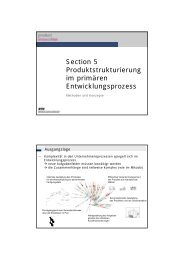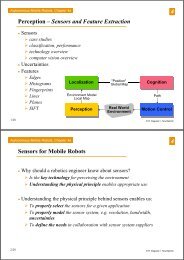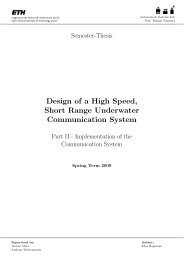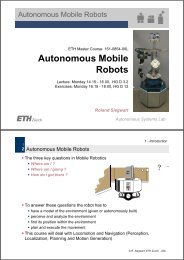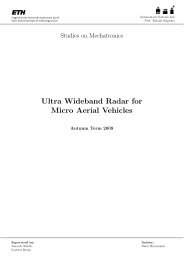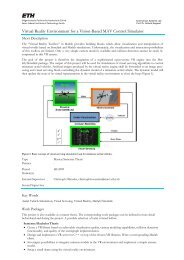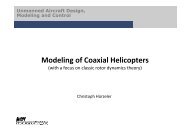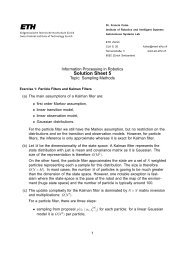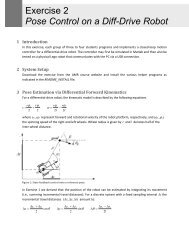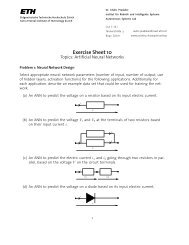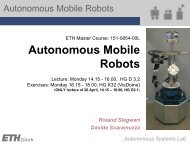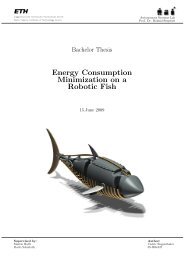Programming a Programmable Logic Controler (PLC)
Programming a Programmable Logic Controler (PLC)
Programming a Programmable Logic Controler (PLC)
Create successful ePaper yourself
Turn your PDF publications into a flip-book with our unique Google optimized e-Paper software.
<strong>Programming</strong> a<br />
<strong>Programmable</strong> <strong>Logic</strong><br />
<strong>Controler</strong> (<strong>PLC</strong>)<br />
Second part<br />
Jens Bathelt<br />
Content of Module 3<br />
— Lesson 3.1, 1h: deepening <strong>Programmable</strong> <strong>Logic</strong>al Controllers<br />
(<strong>PLC</strong>) and explaining Sequential Function Charts (SFC).<br />
— Case 3.1, 2h: <strong>Programming</strong> SFC using SIMATIC S7-Graph<br />
— Lesson 3.2, 1h: The remaining four IEC-1131 languages and<br />
State Transition Diagrams (STD)<br />
— Case 3.2, 2h: Deepening SFC using SIMATC S7-Graph
Objectives<br />
— Able to arrange all five IEC-1131 languages and STD (State<br />
Transition Diagram) according to the software development<br />
process<br />
— Classification of <strong>PLC</strong> programming language properties like<br />
graphical language, close to machine language and high level<br />
language like C.<br />
— Explanation of Basic principles and procedures while using STD<br />
as a programming language.<br />
— Difference between a <strong>PLC</strong> and a Soft-<strong>PLC</strong><br />
— Getting a grip of the IEC 61499 (decentralized intelligence)<br />
Leadslide<br />
requirements<br />
system design<br />
assurance of properties<br />
Control Simulation 3D Visualization<br />
Actors<br />
domain-specific design<br />
Control<br />
Basic System<br />
Sensors<br />
modeling and model analysis<br />
programming<br />
E-CAD<br />
M-CAD<br />
system integration<br />
product
The <strong>PLC</strong> software development versus IEC 1131-3<br />
— STD, State Transition<br />
Diagram (SIEMENS:<br />
HiGraph)<br />
— SFC, Sequential<br />
Function Chart<br />
(AS, Ablaufsprache)<br />
— ST, Structured Text<br />
— FBD, Function Block<br />
Diagram<br />
(FUP, Funktionsplan)<br />
— IL, Instruction List<br />
(AWL, Anweisungsliste)<br />
— LD, Ladder Diagram<br />
(KOP, Kontaktplan)<br />
Other languages (like C, Basic, ..) are possible on many <strong>PLC</strong>’s<br />
level of language<br />
high<br />
low<br />
SFC<br />
1<br />
2<br />
T1<br />
N Fill<br />
S Empty<br />
5 IEC 1131-3 languages<br />
0 1<br />
FBD<br />
analysis design<br />
coding<br />
A<br />
B<br />
AND<br />
LD<br />
C<br />
2<br />
ST<br />
C:=A AND NOT B<br />
LD A<br />
ANDN B<br />
ST C<br />
A B C<br />
-¦ ¦--¦/¦---------( )<br />
Bonfatti F., Monari P. D. and Sampieri U.: IEC 1131-3 <strong>Programming</strong> Methodology, CJ International, France, 1997<br />
IEC 1131 programming languages classification<br />
STD<br />
IL<br />
IAS Universität Stuttgart, 2003
<strong>Programming</strong> language level<br />
— Real time requirement to control a machine<br />
— Robust and not the newest hardware in <strong>PLC</strong>’s (CPU, memory)<br />
LD, Ladder Diagram (KOP, Kontaktplan)<br />
level of language<br />
high<br />
low<br />
SFC<br />
1<br />
2<br />
T1<br />
N Fill<br />
S Empty<br />
STD<br />
0 1<br />
FBD<br />
analysis design<br />
coding<br />
A<br />
B<br />
AND<br />
LD<br />
C<br />
2<br />
ST<br />
C:=A AND NOT B<br />
LD A<br />
ANDN B<br />
ST C<br />
A B C<br />
-¦ ¦--¦/¦---------( )<br />
IL<br />
IAS Universität Stuttgart, 2003
LD, facts<br />
— Derived from the pre-<strong>PLC</strong> relay based controls<br />
— low level language<br />
— graphical language<br />
— SIEMENS: LAD/KOP<br />
— Ladder: ‘Leiter’<br />
LD, Relays<br />
— Relays where used to control the digital machine events in the<br />
past<br />
— <strong>PLC</strong>’s where invented to increase the control power<br />
(Spule)<br />
http://www.plcs.net/chapters/relays7.htm
LD, a simple program based on the former relay example<br />
A coil symbol<br />
—( )—<br />
A contact symbol<br />
LD, logic basics<br />
make contact (Schliesserkontakt)<br />
Sensor Actor<br />
di_switch do_bell<br />
http://www.plcs.net/chapters/replace8.htm<br />
break contact (Öffnerkontakt)
LD, ongoing example<br />
The outputs (Ausgang) A1 and A2 are only set, if<br />
either the input (Eingang) E3 is set or E1 and E2 are<br />
set simultaneously.<br />
IL, Instruction List (AWL, Anweisungsliste)<br />
level of language<br />
high<br />
low<br />
SFC<br />
1<br />
2<br />
T1<br />
N Fill<br />
S Empty<br />
STD<br />
0 1<br />
FBD<br />
analysis design<br />
coding<br />
A<br />
B<br />
AND<br />
LD<br />
C<br />
2<br />
ST<br />
C:=A AND NOT B<br />
LD A<br />
ANDN B<br />
ST C<br />
A B C<br />
-¦ ¦--¦/¦---------( )<br />
IL
IL, facts<br />
— Close to assembler (Maschinensprache)<br />
— low level language<br />
— textual language<br />
— SIEMENS: AWL<br />
— Old language, many experienced users, a lot of generated code<br />
in use in industry, hard to maintain, hard to read for externals,<br />
hard to handle in larger projects, fast, minimal memory usage,<br />
no programming structure.<br />
— The internal representation of all languages in the SIMATIC<br />
standard edition is IL!<br />
IL, ongoing example<br />
and (und)<br />
or (oder)<br />
The outputs (Ausgang) A1 and A2 are only set, if<br />
either the input (Eingang) E3 is set or E1 and E2 are<br />
set simultaneously.
FBD, Function Block Diagram (FBS, Funktionsbausteinsprache)<br />
level of language<br />
high<br />
low<br />
FBD, facts<br />
SFC<br />
1<br />
2<br />
T1<br />
N Fill<br />
S Empty<br />
0 1<br />
FBD<br />
analysis design<br />
coding<br />
A<br />
B<br />
STD<br />
AND<br />
LD<br />
C<br />
2<br />
ST<br />
C:=A AND NOT B<br />
LD A<br />
ANDN B<br />
ST C<br />
A B C<br />
-¦ ¦--¦/¦---------( )<br />
— Drawing functions blocks to express logics (like and/or/not)<br />
according to DIN 40 700 and DIN 19 239 analog to signal flows<br />
observed in electronic circuit diagrams (Stromlaufplan).<br />
— low level language<br />
— graphical language<br />
— SIEMENS: FUP (Funktionsplan)<br />
IL
FBD, logic basics<br />
1<br />
1<br />
and<br />
0<br />
FBD, ongoing example<br />
‘not‘<br />
or<br />
A 4.0 is set if<br />
• E0.0 AND E0.1 are set<br />
• OR E0.2 is NOT set<br />
The outputs (Ausgang) A1 and A2 are only set, if<br />
either the input (Eingang) E3 is set or E1 and E2 are<br />
set simultaneously.<br />
1
ST, Structured Text (Strukturierter Text)<br />
level of language<br />
high<br />
ST, facts<br />
low<br />
SFC<br />
1<br />
2<br />
T1<br />
N Fill<br />
S Empty<br />
0 1<br />
FBD<br />
analysis design<br />
coding<br />
A<br />
B<br />
STD<br />
— Close to Modula-2, Pascal, Basic and C.<br />
— High level language (Hochsprache)<br />
— Textual language<br />
AND<br />
LD<br />
C<br />
2<br />
ST<br />
C:=A AND NOT B<br />
LD A<br />
ANDN B<br />
ST C<br />
A B C<br />
-¦ ¦--¦/¦---------( )<br />
— SIEMENS: SCL (Structured Control Language)<br />
— Like all <strong>PLC</strong> languages embedded in the <strong>PLC</strong> cycle loop. (That is<br />
the major difference to the ordinary use of C, Pascal, ..)<br />
IL
ST, ongoing example<br />
The outputs (Ausgang) A1 and A2 are only set, if<br />
either the input (Eingang) E3 is set or E1 and E2 are<br />
set simultaneously.<br />
STD, State Transition Diagram (Zustandsgraph)<br />
level of language<br />
high<br />
low<br />
SFC<br />
1<br />
2<br />
T1<br />
N Fill<br />
S Empty<br />
STD<br />
0 1<br />
FBD<br />
analysis design<br />
coding<br />
A<br />
B<br />
AND<br />
LD<br />
C<br />
2<br />
ST<br />
C:=A AND NOT B<br />
LD A<br />
ANDN B<br />
ST C<br />
A B C<br />
-¦ ¦--¦/¦---------( )<br />
IL
STD, facts<br />
— STD was/is used as a sketching language to describe the highlevel<br />
states of a mechatronic system on a piece of paper.<br />
— high level language<br />
— graphical language<br />
— SIEMENS: HiGraph, better for the high-level structure design<br />
than Graph (SFC) when designing komplex control software<br />
— Useful as well for mechanical engineers, initial operators<br />
(Inbetriebsetzer), service engineers,.. interdisciplinary<br />
language like SFC.<br />
STD, elements<br />
— States (NOT functions like in SFC)<br />
— Transitions (<strong>PLC</strong>-input)<br />
— Between the states<br />
— Actions (<strong>PLC</strong>-output)<br />
— After fulfilled transition condition<br />
— SIEMENS:<br />
— Entering the state<br />
— During the state<br />
— Exiting the state<br />
— SIEMENS: IL (AWL) is used to describe the transition conditions<br />
and the actions
STD, easy example<br />
SFC versus STD<br />
0<br />
Human Detected<br />
1 Open door<br />
2<br />
Door Open<br />
Door Closed<br />
Wait 2s<br />
SFC<br />
Close door<br />
• Equalities/Differences?<br />
• Actors/Sensors?<br />
0 Door Closed<br />
1 Door Opening<br />
2 Door Open<br />
3 Door Closing<br />
? Condition (C)<br />
! Action (A)<br />
C: Human Detected<br />
A: PC > Work Position<br />
C: Door Open<br />
A: Wait 2s<br />
C: 2s waited<br />
A: PC > Basic Position<br />
C: Door Closed<br />
STD<br />
C: Condition PC: Pneumatic Cylinder<br />
A: Action
Summarizing all discussed languages<br />
LD IL FBD ST SFC STD<br />
Low level X X X<br />
High level X X X<br />
Textual X X<br />
Graphical X X X X<br />
SIEMENS LAD/KOP AWL FUP SCL Graph HiGraph<br />
German KOP AWL FBS ST AS Zustandsdiagram<br />
level of language<br />
high<br />
low<br />
SFC<br />
Soft <strong>PLC</strong> versus <strong>PLC</strong><br />
1<br />
2<br />
T1<br />
N Fill<br />
S Empty<br />
0 1<br />
FBD<br />
analysis design<br />
coding<br />
A<br />
B<br />
STD<br />
AND<br />
LD<br />
C<br />
2<br />
ST<br />
C:=A AND NOT B<br />
LD A<br />
ANDN B<br />
ST C<br />
A B C<br />
-¦ ¦--¦/¦---------( )<br />
IL
<strong>PLC</strong> (<strong>Programmable</strong> <strong>Logic</strong> Controller)<br />
— A <strong>PLC</strong> (i.e. <strong>Programmable</strong> <strong>Logic</strong> Controller) is a device that was<br />
invented to replace the necessary sequential relay circuits for<br />
machine control. The <strong>PLC</strong> works by looking at its inputs and<br />
depending upon their state, turning on/off its outputs.<br />
Machine controlled by a <strong>PLC</strong><br />
Actuators<br />
Control<br />
Basic system<br />
Sensors<br />
http://www.plcs.net/
Machine controlled by a Soft-<strong>PLC</strong><br />
Actuators<br />
SIEMENS Soft-<strong>PLC</strong>: <strong>PLC</strong>Sim<br />
Control<br />
Basic system<br />
<strong>Programming</strong> Environment:<br />
- defining the I/O’s<br />
- programming<br />
- compiling<br />
Soft-<strong>PLC</strong>:<br />
Control; processing the signals<br />
Sensors
Trends in automation<br />
— Wireless Automation<br />
— Combining <strong>PLC</strong> & CNC<br />
(SIEMENS: SIMATIC, SINUMERIK SIMOTION)<br />
— Decentralized intelligence<br />
Decentralized intelligence<br />
— Decentralized intelligence<br />
— Wireless Automation<br />
— Combining <strong>PLC</strong> & CNC<br />
(SIEMENS: SIMATIC, SINUMERIK SIMOTION)
Why decentralized intelligence?<br />
— Verified and reliable modules can be reused<br />
— It is easier to extend HW/SW due to the encapsulation of<br />
intelligence<br />
— Faster initial operation due to envisioned “plug&play”<br />
— Manufacturer can enhance their components by SW (intelligent<br />
actuators, ..)<br />
The Interface has to be standardized<br />
Standardized Interfaces enabling distributed intelligence
New Standard: IEC 61499<br />
— Initial work on the IEC 61499 started in 1992<br />
— Official standard since 2005<br />
— Reference model for distributed automation<br />
— No inherent hierarchy for field devices (“Gleichberechtigung”)<br />
— The control logic is distributed and executed on the field devices<br />
— No central <strong>PLC</strong> “on the top”<br />
— Extending function blocks as known from:<br />
— IEC 61131-3 Function Blocks (<strong>PLC</strong>)<br />
— IEC 61804 Function Blocks (Distributed Control Systems)<br />
— Object (component/module/device) oriented<br />
— Data encapsulation/interfaces & reusability..<br />
— Event oriented signal processing<br />
— As classified in the following slide..<br />
Overview of control types<br />
Sequential circuit<br />
(Schaltwerke)<br />
<strong>Logic</strong> control<br />
(Verknüpfungs-<br />
Steuerung)<br />
Combinatorial circuit<br />
(Schaltnetze)<br />
Electrical Controls<br />
(Elektrische Steuerungen)<br />
time bounded<br />
(zeitgeführt)<br />
Sequential control<br />
(Ablaufsteuerung)<br />
Cyclic signal<br />
processing (zyklische<br />
Signalverarbeitung)<br />
process bounded<br />
(prozessgeführt)<br />
Event oriented signal<br />
processing (ereignisorientierte<br />
Signalverarbeitung)
Object oriented aspects in IEC61449 function blocks<br />
(Kapselung)<br />
(Vererbung)<br />
(Polymorphismus<br />
“Vielgestaltigkeit”)<br />
http://www.searcheng.co.uk/selection/control/Articles/IEC61449/page3.htm<br />
IEC 61499: concept
Function block according to IEC 61499<br />
Simple Example: flow control<br />
— Amount of intelligent components?<br />
New in IEC 61499<br />
IEC 1131
Research topic: (Re)configurable mechatronic modules<br />
SW representation of<br />
(re)configurable mechatronic modules<br />
© Profactor Produktionsforschungs GmbH 2006<br />
Objectives<br />
Production System Machines Intelligent components Basic Components<br />
HW representation of<br />
(re)configurable mechatronic modules<br />
— Able to arrange all five IEC-1131 languages and STD (State<br />
Transition Diagram) according to the software development<br />
process<br />
— Classification of <strong>PLC</strong> programming language properties like<br />
graphical language, close to machine language and high level<br />
language like C.<br />
— Explanation of Basic principles and procedures while using STD<br />
as a programming language.<br />
— Difference between a <strong>PLC</strong> and a Soft-<strong>PLC</strong><br />
— Getting a grip of the IEC 61499 (decentralized intelligence)



